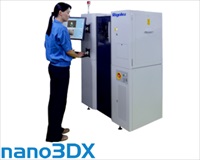Members Login

Channels
Special Offers & Promotions
Rigaku Launch New X-Ray Microscope at ACMM23/ICONN2014
Rigaku and AXT are pleased to announce the simultaneous release of the nano3DX x-ray microscope in Australia and America.
 In Australia this new product was launched at ACMM23/ICONN2014 (the 23rd Australian Conference on Microscopy and Microanalysis and the International Conference on Nanoscience and Nanotechnology).
In Australia this new product was launched at ACMM23/ICONN2014 (the 23rd Australian Conference on Microscopy and Microanalysis and the International Conference on Nanoscience and Nanotechnology).
The nano3DX is a new product for Rigaku who have a long history and significant expertise in analytical x-ray related technologies such as x-ray diffraction (XRD), x-ray fluorescence (XRF) and non-destructive testing (NDT). It is a true x-ray microscope (XRM) with the ability to measure relatively large samples at high resolution.
As an x-ray microscope, the nano3DX images the entire sample from multiple angles. In doing so it can reconstruct a 3D image at 0.27µm resolution. The computer model allows the user to view sections on any plane, at any point providing valuable insights into the structure of the sample.
The secret behind the Rigaku XRM is the high power rotating anode and high-resolution optics coupled with sub micron CCD technology. This combination is capable of both fast data collection and the ability to switch anode materials rapidly to optimise data acquisition. Furthermore, the magnification occurs in the detector which uses true microscope elements.
The geometry of the system allows the sample to be located very close to the high-resolution detector which provides near-parallel beam optics. This design results in improved instrument stability which prevents smearing, faster data collection times and ultimately the highest resolution x-ray microscope in its class.
One of the other advantages of the nano3DX over other instruments is its ultra-wide field of view. The nano3DX is able to deliver measurable volumes up to 25 times larger in a single scan compared to other systems at similar resolutions in comparable time frames.
Primary anode materials used in the nano3DX are copper, chromium and molybdenum. The choice of these anode materials gives the system the flexibility to optimise the x-rays for penetration and contrast based on the varying atomic weights of materials present in the sample.
X-ray microscopy is suited to all kinds of different materials from low density materials such as biological samples to high density materials such as ceramics and steels. XRM is even suitable for those materials with low absorption contrast like CFRPs and pharmaceuticals.
Applications for the nano3DX are many and varied from materials science, to electronics and semiconductors, to mining and minerals exploration, all the way to life sciences and pharmaceuticals.
The Rigaku nano3DX is now available in Australia and New Zealand through AXT and will also be promoted at AXAA 2014.
Media Partners


